
Conference Report “The East is not Exit”, Košice, 28th November 2017
Place: Košice, Slovakia Date: 28th November 2017
More...We kindly inform you that, as long as the subject affiliation of our 300.000+ articles is in progress, you might get unsufficient or no results on your third level or second level search. In this case, please broaden your search criteria.

Place: Košice, Slovakia Date: 28th November 2017
More...
The article aims to provide a review of the currently most accepted models explaining transition and adjustment to retirement, which include role theory, continuity theory, life course perspective, and the resource-based dynamic model for retirement adjustment. One of the main theories explaining adaptation to retirement is role theory. This theory assumes that during the transition from one life period to another, an individual exits one role and enters a different role (George, 1993). Based on this theory, retirement can be characterized as a role transition (Riley & Riley, 1994), when a job role is weakened or even lost, and roles associated with family and community are strengthened (Barnes-Farrell, 2003). In cases when an individual’s job role is central to their identity and they are overly-engaged in their job, transition to retirement is more difficult compared to an individual who perceived their job role as more stressful, more demanding or who had experienced more conflicts with their co-workers. Transition to retirement, thus, can be experienced as a relief, where there is an opportunity to engage in family and community roles in newly-acquired leisure time (Osborne, 2012; Wang, Henkens, & Solinge, 2011a). Unlike the emphasis on role change, the continuity theory argues that retirees adapt effectively to a new life-period if they have developed relationships, activities, a framework of thinking, and adaptive skills during their previous life-period and if they continue to use them after being retired, and thereby they maintain continuity (Atchley, 1989). Research suggests that an individual can maintain continuity even through part-time employment (Feldman & Beehr, 2001) or by maintaining leisure activities (Pushkar et al., 2011) after retiring. Continuity theory, therefore, suggests that a retired person is directly responsible for creating an adaptation strategy which may help them in their transition. Life course perspective theory, on the other hand, discusses two main factors influencing retirement: a) individual history - including past life transitions, working and recreational habits (Carr & Kail 2013), and b) individual attributes - such as demographics, health and financial status and transition capabilities (Griffin & Hesketh 2008; Wang, 2007). From a life course perspective, an individual who has flexibly addressed previous life transitions, who has been less socially integrated with their job and co-workers, and who has attributes effective for retirement adaptation, will experience a smooth transition to retirement (van Solinge & Henkens 2008; Wang & Shultz, 2010; Wang, et al., 2011a). A current model explaining the adaptation to retirement is the resource-based dynamic model for retirement adjustment, which recognizes adaptation as a process that depends on individual resources and changes of these resources (Wang et al., 2011a). The resources can be defined as the overall ability of an individual to meet their needs and are divided into seven categories: a) physical resources, including health or physical strength (Jex, Wang, & Zarubin, 2007); b) cognitive resources, including, for example, work memory (Wang & Chen 2006); c) financial resources, such as wage and retirement benefits (Hobfoll, 2002); d) social resources, e.g. social networking and social support (Kim & Feldman, 2000); e) emotional resources, such as emotional stability, sensitivity, mood (Wang, Liao, Zhan, & Shi, 2011b) and f) motivational resources, e.g. self-efficacy.
More...
A number of studies adopting either Hofstede ́s Cultural Values Survey approach or Schwartz ́s concept of Value Types have documented major distinctions in value preferences between Czechs and Slovaks. The most prominent one has been represented either by the dimension of Masculinity (as constructed by Hofstede) or value type of Achievement (a concept of Schwartz); both defined by similar content, stressing the importance of success, achievement and competence. In all the five published comparisons so far – two based on Cultural Values Survey by Geert Hofstede (Kolman, Norderhaven, Hofstede, & Dienes, 2003, Bašnáková, Brezina and Masaryk, 2016) and three on value types by Shalom Schwartz (Schwartz & Bardi, 1997, Schwartz, Bardi & Bianchi, 2000 and Ilgová & Ritomský, 2009), -- Slovak participants scored higher in both Masculinity (MAS) and Achievement. Interestingly, Slovakia´s MAS score reported by Kolman et al. (2003) reached one of the highest values of all the surveyed countries with the VSM instrument, thus becoming an international outlier. As we concluded in our previous report of cross-cultural differences in Bašnáková et al. (2016), it remains puzzling why two nations that share a similar geographical and historical context would differ on the Masculinity dimension by such a large margin. In this study, we therefore aim to explore this difference in more detail. For that purpose, we contrasted two matched samples of Czech (N=200) and Slovak (N=200) participants representative of the two populations. In essence, we believe that there are two possibilities behind the difference in Masculinity. Firstly, the reported difference between Czechs and Slovaks is psychologically valid and therefore can be explained in terms of another number of cultural dimensions, such as the value system by Schwartz, and/or by underlying demographic factors. However, we cannot a-priori exclude a more mundane reason for the difference. Secondly, that it is simply an artefact of the questionnaire brought about by a small number of outlying items; for example because there are systematic differences in how participants in the two countries interpret a particular item. In order to differentiate between these two positions, and create a more grounded reference, we focused our analysis on three issues: (1) Identification of demographic factors that relate to Masculinity in both samples, (2) Comparison of Masculinity with Schwartz’s individual value types, (3) Analysis of the items constituting the Masculinity index. As for demographic factors, there is a possibility that the difference between Czechs and Slovaks on Masculinity is caused by some underlying factor(s), which in itself is not a cultural-psychological dimension of value differences but can explain the level of a studied value.
More...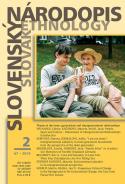
This article focuses on intergenerational solidarity in three-generation households. Drawing upon in-depth interviews with seven members of the oldest generation cohabiting in a three-generation household, the article investigates the aspects, perceptions, and meanings of intergenerational solidarity. The article is based mainly on the theory of intergenerational solidarity presented by Alice S. Rossi and Peter H. Rossi (1990) and Robert E. L. Bengtson and Vern L. Roberts (1991). We are inspired by the classification of solidarity into seven dimensions - associational solidarity, effectual solidarity, consensual solidarity, functional solidarity, normative solidarity, and intergenerational family structure - and observe these dimensions in the context of three-generation co-living. Using a qualitative approach allows us to capture the emic perspective of the interviewees and their perceptions of intergenerational relations and their position within a three-generation household.
More...
In a study of dating in later life, conducted in the Midwest in the United States, in which a sample of people age 60+ were interviewed regarding their dating behaviors and perceived functions of dating at this stage in the life course, preliminary evidence suggests that middle-generation offspring took on the role of gatekeepers of sexual standards of conduct and cohabitation outside marriage. Concomitantly, the older generation displayed modified attitudes about sexuality outside marriage in keeping with the opportunity structures available to them as part of the dating experience. When this paper was published in 1986 there were few studies of later life intimacy and dating, and the focus was on the older daters rather than on extended family or social network implications of dating in later life. Since my study in the mid-1980’s, research has flourished on later life dating and intimacy, but the focus continues to be on the dyad rather than exploring intergenerational family relationships and changes that result from re-coupling in later life. This paper will explore the adult child-older parent relationship in which the older person is dating and posit research questions based on two conceptual areas and one theoretical perspective – stereotyping of older people, transmission of values across generations, and social exchange theory – on which to build future studies of intergenerational relationships. This review of the literature will assist in understanding the middle generation’s response to an older parent’s dating and courtship behavior as well as consider why conflicts about later life dating between adult children and older parents are more likely under certain family conditions. Exploration of the literature on later life dating that has resulted since our 1986 study, coupled with theoretical underpinnings, is intended to help scholars in this area of study conduct research that will be more generalizable and theory-based.
More...
Conference Report “Border Changes and Population Movement in Europe after the Second World War”, Košice, Slovak Republic, 19th – 20th September 2019
More...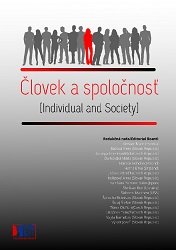
Background: Previous research on the perceived causes of poverty has been carried out in the field of sociology (Strapcová, 2005) as well as social psychology (Nasser & Abouchedid, 2001). This research has looked at individuals' perceptions of the causes of poverty and the effect of various sociodemographic variables such as social class (Kluegel & Smith, 1981), income (Lever & Trejo, 2004), subjective assessment of one's economic situation (Strapcová, 2005), gender (Bullock, 1999), age (Niemelä, 2008), education (Hunt, 1996) and employment (Strapcová, 2005). The majority of these studies have been conducted on people who have not directly experienced poverty such as university students (Cozzarelli et al., 2001), middle-class people (Kluegel & Smith, 1981) and social workers (Bullock, 2004). Therefore, there have only been a few studies done on how poor people perceive the causes of poverty (Bullock, 1999; Davids & Gouws, 2013; Morçöl, 1997). Research goal: The present study has two objectives. The first one was to determine whether there are statistically significant differences in the individualistic, structural and fatalistic perceived causes of poverty between the objectively poor and objectively non-poor as well as between the subjectively poor and subjectively non-poor. Secondly, it was to identify the predictors of the individualistic, structural and fatalistic perceived causes of poverty among selected variables including gender, age, marital status, employment status, education, objective poverty and subjective poverty. It was hypothesized that the objectively poor would prefer less individualistic and more structural as well as fatalistic perceived causes of poverty in comparison with the objectively non-poor. It was also hypothesized that the subjectively poor in comparison with the subjectively non-poor would prefer less individualistic and more structural as well as fatalistic perceived causes of poverty. In addition, it was assumed that sociodemographic variables such as objective poverty, subjective poverty, gender, age, marital status, employment status and education would be significant predictors of the structural, fatalistic and individualistic perceived causes of poverty. In particular, it was hypothesized that objective poverty, subjective poverty, gender, and age would be confirmed as positive predictors of structural and fatalistic perceived causes of poverty while marital status, employment status and education would be confirmed as negative predictors. Within the individualistic perceived causes of poverty, it was hypothesized that marital status, employment status and education would be significant positive predictors while objective poverty, subjective poverty, gender and age would be significant negative predictors. Method: The research sample consisted of 150 respondents (77 men and 73 women) aged between 19 and 64 years old (M = 36.67; SD = 13.23). In terms of education, 17 participants stated that primary school had been their highest level of education, 31 participants stated that they had left secondary school without A level exam, 46 participants had left with A level exam and 56 participants had a university degree (15 of them had a Bachelor's degree, 39 participants had a Master’s and 2 participants had a PhD). In terms of marital status, 73 participants were single, 8 cohabitated, 49 were married, 13 were divorced and 7 widowed. With regards to employment status, 79 participants were full-time employed, 11 worked part-time, 27 were unemployed, 7 were retired, 6 were on sick/disability leave invalid retirees and 20 respondents reported their employment status as “other“ (9 of them were self-employed, 9 were students and 2 were on maternity leave). The data were dichotomized into groups according to age (19-25, 26-45, and 46-64 years old), according to relationship status (those not in a relationship and those who are), groups with lower and higher educational attainment and groups of non-working and working participants. For the data collection, occasional sampling was conducted in seven charitable organizations in the regions of Prešov, Košice, and Banská Bystrica in Slovakia. In addition, voluntary response sampling was used through an online survey. In order to assess the perceived causes of poverty, the Attributions for Poverty questionnaire (Bullock et al., 2003) was used. The subjective assessment of poverty was measured by the question “In your economic situation, is it possible to make ends meet?” (Nygård et al., 2017). The equivalent disposable household income of each respondent was calculated as an indicator of objective poverty. The research data were analysed in the statistical program IBM SPSS Statistics. Both a Welch t-test and Mann-Whitney U test were used to verify the first goal of the study. For the second goal, a multiple hierarchical linear regression analysis stepwise method was used. Results: There were statistically significant differences found in the structural as well as fatalistic perceived causes of poverty between the objectively poor and objectively non-poor as well as between the subjectively poor and subjectively non-poor. The objectively poor and subjectively poor were found to have higher scores in both the structural and fatalistic perceived causes of poverty in comparison with the objectively non-poor and subjectively non-poor. There were no statistically significant differences found between the objectively poor and objectively non-poor nor between the subjectively poor and subjectively non-poor in the individualistic perceived causes of poverty. The results of the regression analysis showed that when the 9 predictors were inputted in three blocks (1. gender, age-3 groups, marital status, 2. education, employment status, 3. objective poverty, subjective poverty), none of them appeared to be significant in terms of the individualistic perceived causes of poverty. For the structural as well as fatalistic perceived causes of poverty only one of the input predictors was shown to be positively significant. Subjective poverty was found to explain 4.2% of the variance in structural and 8.3% in the fatalistic perceived causes of poverty. Conclusion: The findings provide insight into the widely up to now unexplored issue of perceived causes of poverty in Slovakia. Future research on the perceived causes of poverty among the poor could focus on self-assignment of the participant to either the group of the poor or non-poor, distinguish between one's own poverty and the poverty of others and include other variables such as ethnicity, religion, belief in a just world as well as life satisfaction.
More...
People usually think about age as an objective data indicated in their official documents. However, there is a subjective side to it: the age we associate to an individual’s life-cycle – youth, middle age, and old age – depends on the social-economic context we live in. At the same time an individuals’ perceptions about age become elements of demographic trends, as individual decisions about major life events are influenced by perceptions about the ideal age of these event, i.e., which age is ideal to move from the parental home, start a relationship, give birth to the first child or retire from work. These very personal decisions are greatly influenced by the expectations or even norms posed by the broader society and the narrower community we live in. Social norms associated with age may also change in accordance with more general developments in medical science, expansion of education or policy areas related, for example, to childcare services or retirement. In our paper we examine perceptions about the lifecycle and timing of life and their respective changes in a European comparison. The analysis will use data from the Timing of Life questionnaire module of the European Social Survey (ESS) and compare data from Round 4 in 2006 and Round 9 in 2018. Our analysis triangulates the perception of the timing of life, demographic characteristics of societies and the policy context. Our analysis found that perceptions about ages associated to the lifecycle and major life events have shifted: in all respects people tend to associate a later age to these. The most prominent changes happened in societies of Central East Europe with regard to ages associated with the ideal and latest age of childbearing. There is a slow but explicit convergence of perceptions about age in post-communist countries in Eastern Europe with more long-time democracies in Western Europe. The changes are fuelled primarily by young people’s significantly different perceptions compared with the middle-aged and elderly. The trend of later ages seen as an ideal for key life events especially that of childbearing, is an important driver of further in the aging of European societies.
More...
Postponement of childbearing and age pluralization of reproduction are the main features of the transformational changes in the fertility process in Slovakia in the last three decades. The advanced reproductive age is increasingly used for the realization of reproductive intentions and, therefore, this paper evaluates long-term trends in fertility at age 35 and over and its significance for overall fertility within the context of changes that took place after 1989. The results confirm an increase in the level of and in the contribution of late fertility to the overall reproduction in Slovakia. However, this trend has stagnated in recent years and the level and contribution of late motherhood to oveall fertility lags significantly behind the situation observed in the interwar period. Futher, the paritystructure of late childbearing has transformed. We find that the contribution of second and higher parity births has been reduced in favour of first births. With respect to non-maital childbearing, we find that it is below average in the advanced reproductive ages, in spite of rapid increase of overall share of non-marital births in the past 30 years. We use differential analysis of the late fertility to investigate trends in population subgroups. The intensity of late childbearing has increased regardless of marital status, educational attainment, ethnicity or place of residence of the mother. At the same time, however, there was a certain divergence between the observed groups of women. Late motherhood is thus associated primarily with never-married and married women, with those having lowest and highest educational attanments, of Slovak ethnicity and with those permanently resident in the urban environment, particularly in the largest cities and, consequently, in the Bratislava region.
More...
Most walking-related research focuses on the spatial behaviour of the adults living in the studied areas and omits other pedestrians. The aim of this study was to uncover possible differences in the spatio-temporal patterns of adolescents’ walking activities, according to the location of their residence. The research was carried out in an electoral ward in the post-socialist town of Banská Bystrica (Central Slovakia). A total of 295 participants aged 13 to 16 years (103 of whom were residents of the ward) recorded their walking activity at hourly intervals. The residents of the ward were only more active than other pedestrians during a few afternoon and evening periods, with differences up to 13:00 not being significant at all. The lowest dispersion of walking activity space was recorded for participants residing other municipalities. The lesser walking activity by non-residents is in line with current knowledge of the spatio-temporal constraints of commuting individuals, and the time-budget theory.
More...
By commonly requiring smaller walking distances, elderly have been considered more vulnerable when accessing urban facilities, and thereby have fewer urban opportunities than an “average adult”. Yet is not clear if this disadvantage remains significant after considering the different needs of the elderly. The main aim of this study was to provide an analysis of the spatial distribution of urban facilities, while considering differences in preferences for facility types of the elderly (over 65 years of age) and adults (under 65 years of age). Participants residing Fiľakovo (Slovakia) were asked to state a visitation frequency of urban facilities. All the facility types mentioned by the residents were then mapped. Accessibility to opportunities was calculated in a trigonometric model of fictitious public space users, with the differences between the age groups being tested with a Mann-Whitney U test. Areas of interest for adults and the elderly were calculated using Kernel density analyses. The results showed that even after considering the different needs and preferences of the elderly, there were still significant differences in opportunities within their walking distance compared to adults. The spatial patterns of the areas of interest were similar, but with higher values of the kernel density in the case of adults. Inequalities emerged particularly in areas where facilities catering to daily needs were absent. Indeed, to mitigate the socio-spatial injustice, it would be beneficial to deconcentrate the municipality-controlled facilities.
More...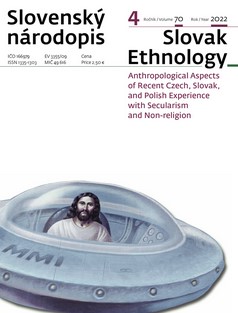
Non-religious identity, just like religious identity, is a matter of long evolution over time that often crosses multiple generations. Many papers have shown that young adulthood seems to be the key period of life when the personality is formed and often reaffirms its religious and worldview identity as well. I attempted to outline how this process can be extrapolated from the Census 2021 data, the ISSP Religion 2018 and 2008 surveys, as well as interviews with several young people to reveal the background of this transformation. The most significant evidence we see in the national census data is that the age of early adulthood is notable for the sudden growth of non-religious people (nones) and a decrease of Roman Catholics. Such a transformation seems to be crucial in terms of the background identities of nones in contemporary Slovakia, where a slight majority of nones were raised in any of the denominations. Although such transformations are only small, they seem to be essential and deserving of attention in the process of general changes in the religious landscape of a secularising Slovakia.
More...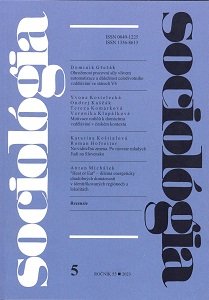
In this study, we focus on the return of young migrants from abroad. We understand return as one phase in the migration cycle. We show that the experience of living abroad leads to changes in the social behavior of young people, as well as to changes in the structure of their values in a broader sense. We also reveal that return serves as a catalytic process in which young returnees understand their own changes while living abroad in contrast to the situation in their society of origin. Therefore, the first part of the study presents return as a dynamic process of personal and cultural transformation. The second part of the paper focuses on social remittances which are analyzed as sources of innovation in the country of origin. Then, in the third part, we deal with the role of young returning migrants in spreading innovation in families, local communities and in the wider society.
More...
Emerging adulthood (Arnett, 2015) is a period in which intimate partner relationships are explored. Based on our pilot study, this research maps the experience of intimate relationships in emerging adulthood using a representative sample of Slovakia. In addition to a factor analysis (as in the pilot study) to identify categories of attributes of intimate relationships, we also performed a complementary "Q" analytical procedure - identifying latent classes of participants. We revealed 4 classes of participants with a special "group subjectivity" related to similar experience in intimate relationships. In addition to mapping intimate relationships in Slovakia, the study also has an epistemological contribution to sociology in that it makes visible the significant relationships of members of a particular latent class to other predictors/variables and thereby better understand "membership" in individual latent classes.
More...
The declaration of a second ethnicity in the 2021 census in Slovakia marks a significant shift in demographic data collection practices. This census was the first of its kind in Slovakia to allow respondents to indicate multiple ethnic identities. This change not only underscores the increasing diversity within Slovakia's population but also sheds light on the varied positions held by certain ethnic groups within our cultural landscape. The data revealed that the largest ethnic group, Hungarians, predominantly identify as monoethnic. In contrast, the Roma and Ruthenians exhibit a notable proportion of individuals declaring more than one ethnic identity. This phenomenon appears to be influenced by specific geographic and educational attainment patterns. Our research aims to delve into the methodological and psychological aspects of declaring a second ethnic identity. By examining these factors across different contexts, we seek to provide a foundation for future studies in this field. In doing so, we hope to incorporate a broader range of social and spatial parameters to enrich our understanding of ethnic identity dynamics in Slovakia.
More...
Transhumanism advocates the development and use of technologies to eradicate disease and suffering, enhance humans’ abilities, and extend humans’ life spans. Some such technologies are currently in use, including prosthetics to facilitate movement and medications to enhance focus. As technologies become increasingly sophisticated, it is likely that they will be accessible to relatively few individuals as a result of their cost and availability. We examine the potential impact of a Western society’s increasing use of enhancements by a privileged segment of its population on its understanding of disability as compared with current models of disability and associated ethical issues.
More...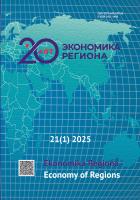
In modern society, population aging has become one of the most pressing demographic challenges. Increasing life expectancy and low fertility rates are reshaping age pyramids across many countries. This article examines how factors describing the age structure of the population influence the growth rate of total factor productivity (TFP). The study tests the hypothesis that population aging has a positive relationship with TFP growth. To calculate TFP growth, the study employs an approach based on the dual method of estimating the Solow residual, which accounts for potential distortions in the regional distribution of capital in Russia. Due to data availability, the analysis considers statistical data for Russian regions up to 2021. The calculated Solow residuals vary significantly across regions. For example, in Moscow, the Solow residual is 0.06 % (just 2.5 % of GRP growth), whereas Russia’s average annual GRP growth rate is 0.75 % (17.6 % of the average annual growth rate of real GRP per capita). The study examines several indicators of age structure, including the dependency ratio, median age, mean age, and the ratio of mean to median age. Moran’s index calculations confirm the expected significance of spatial correlation. Spatial econometric models, specifically the spatial lag model (SLM), reveal that age structure factors significantly influence TFP growth. The results show that both median and mean age positively impact TFP growth. The estimated effects of changes in age structure on TFP can be used to forecast regional economic development while considering demographic trends.
More...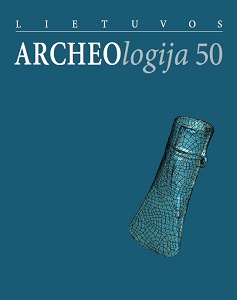
Much of archaeology takes the human body into account when it comes to recording, analysing and interpreting graves. Human remains are encountered as dead matter, and often scrutinized with osteological and bioarchaeological methods and approaches. Bioarchaeological methods enable us to obtain a wide range of data on diet, ancestry, mobility and so on; yet bodily remains thus tend to be understood primarily as a repository of data and such a view of the human body is rather positivistic. Here, I want to sketch an approach that goes beyond the notion of the human body as a container and focuses not only on the body in relation to death and dying. The starting point is the idea that the human body is central to all spheres of human society and activity, as all social interaction is body-based. My objective is to go beyond the representational character of bodies and to include their phenomenology into the study of human remains.
More...
The article talks about the devastated villages in the Zhamuri valley”. Zhamuri valley begins at the shores of lake “keli”, where the Ksani river originates and extends through the territory up to karchokhi valley. While researching the issue, we initially concentrate on the 10th century book of Sargo Samtavneli. This variant is written in “Nuskhuri” and is found in the collection of church documents curated by the renowned scholar S. Kakabadze, included in his historical collection. Zhamuri is directly mentioned in the sources, indicating that traces of the Georgian population can be found here from the very beginning. Remarkable information about the Zhamuri valley is found in “Aghtsera”, a work by the famous Georgian historian and geographer Vakhushti Batonishvii , from XVIII century. In his notes, he mentions that Georgian peasants used to inhabit this area. Later, they moved to the dale and Ossetians from the North Caucasus replaced them here. The historical fact, that, right Georgians were the people who inhabited the territory of Zhamuri before their arrival, is not only confirmed by the X century book of Sargo Samtavneli , which has been previously mentioned, but is also substantiated by other sources, worth noting is the XV century book of Samtavneli, specifically its worshipper's drama and introduction, where Zhamuri is also referenced. The opinion of I. Gagoshidze is noteworthy, while discussing the IVIII centuries BC, he emphasizes the toponymic coincidence between Bagini of Zhamuri valley and Bagineti of Mtskheta and indicates, that during this period the population moved from Ksani valley to the dale. To study the past of Zhamuri valley, it is crucial to analyze the architectural monuments here, as Vakhushti Batonishvili notes, there are many tall and wellbuilt towers in the valley, with Bertsikhe standing out. Researchers date the back tower of the castle-complex to the Middle Ages and the cylindrical tower at the southern end to the XVIII century. The church without an Aspe standing between the towers is considered to be the oldest. Among the fortification buildings of Zhamuri valley, the Alaverdi castlecomplex is also noteworthy and Parmen Zaqaria searches for its analogue in monuments from the IX to X centuries. Apart from Bertsikhi and Alaverdi there are several stand-alone watchtowers in Zhamuri valley, including Bagin, which according to general data, dates from the end of the XVI to XVII centuries. The work explains the names of Zhamuri and explores the existing architectural monuments, illustrating the religious existence of the valley's inhabitants. The main part of the research is devoted to the demographic situation, here the period of settlement and life of the Ossetian population, both the lists of the XVIII century andthe IX-XX centuries are reviewed. Most of which are published for the first time, according to Russian chamber censuses of the IX century , we can conclude that there were 18 villages in Zhamuri by the end of the XIX century : Babuaantkari(1 household), Valag Bagini (16 household) Middle, below Bagini (11 households), Gorga (3 households), Gurtsiaantkari (10 households) Jaantkari (Jiantkari) (3 households), Dzotsiaantkari (5 households), Kapikavi( 3 households) Kora (12 households) , Kurdikomi (1 household), naviskhevi (4 households) , Fagiantkari (5 households), Sago (5 households), Sigda (1 household), Togoiantkari (4 households) , Farniantkari (1 household), Tsinasofeli (3 households) , Chigoiantkari , Dalakau (13 households) , here used to live : Biganashvilebi, Bitarashvilebi , Gurchishvilebi, (Gurtsishvilebi), Gabloshvilebi, Jebisashvilebi, Medoshvilebi, Togoshvilebi, Farnishvilebi, Fagishvilebi, Choghoshvilebi, Goloshvilebi… they were orthodox Christians. The lands and serfs in Zhamuri, belonged to the nobility of Ksani. The last villages, where the population still lived until the 1980s of the XX century. At the time of the 1989 census, no one lived in the Zhamuri valley.
More...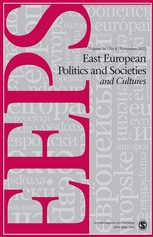
This article asks if the measures of human capital, ethnic diversity, and gender equality from 1930 explain current levels of human capital in Romania, while also assessing the role of macro-regional differences in the manifestation of historical legacies. We focus on human capital, measured by educational attainment and by conscientiousness, a personality trait we estimate with a behavioral measure. The analysis is based on a recent large-scale national survey from 2019–20 and census data from 1930. We find that contemporary human capital levels are influenced by a combination of factors, including historical human capital levels, ethnic diversity, and gender equality. Additionally, we show that the long-term impact of these factors can vary by region. Specifically, our study identifies four distinct long-term effects within the historical region of Transylvania and two in the rest of the country. In Transylvania, the present educational attainment is shaped by both the 1930 literacy rate and gender equality, while in the other regions, only the literacy rate exerts a statistically significant influence. Similarly, when it comes to current levels of conscientiousness, Transylvania’s levels are affected by both the 1930 literacy rate and ethnolinguistic fractionalization, whereas in the rest of the country, only ethnolinguistic fractionalization has a statistically significant impact.
More...